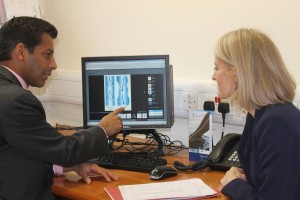There are many veins which return blood from the legs to the heart. Within these veins are valves which control and direct the flow of blood in the right direction. With varicose disease these valves fail and allow blood to fall back with gravity causing bulging of the veins on the surface of the legs. Over long periods this may result in aching, skin changes, swollen legs or ulceration.
A venous duplex ultrasound scan is a non-invasive, harmless diagnostic test for assessing varicose veins and other circulatory disorders. The examination included the use of “Doppler” which is a special application of ultrasound necessary to assess blood flow. This provides precise information on the normal and abnormal anatomy, and assessing the speed and direction of the blood flow. In particular there is detailed examination of the important great and small saphenous veins, as well as the deep veins in which clots (DVT) sometime occur. This information is used to form a map of your veins which is essential in planning the correct treatment, thereby ensuring the optimum result and minimising the chances of veins returning in the future (recurrence).

The ultrasound scan is usually performed whilst you are in a standing position on a low footstall equipped with a handrail, or lying down and takes approximately 10-15 minutes per leg. They are examined with a plastic probe and contact jelly from the groin to ankle and from the back of the knee to the heel. The legs may be gently squeezed to move blood through the veins, and this can occasionally be uncomfortable at the time. Please let the sonographer know if there are any particularly tender areas before you have the scan. The results of the ultrasound scan are available immediately as a diagram and written report. This allows Mr Ray to see you and discuss the various treatment options during your visit, rather than make a separate appointment later.

A scan is also useful a few weeks after the treatment to confirm success of the procedure, exclude DVT, and to direct any further treatment that may be required.
Please check that you have confirmation of cover/authorisation number for the ultrasound examination from your private medical insurer, as otherwise you may be personally invoiced by the hospital.
